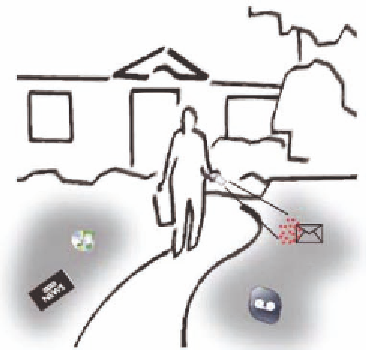Information Technology Reference
In-Depth Information
and the broader environment. In such
negotiated
interaction
systems, the control changes fluidly
as the context determines. The user and the com-
putational system work together to negotiate their
interactions and communicate their intentions in a
fluid, dynamic manner (Williamson, 2006). Timed,
informative feedback shares the load between
both sides, and the interactions occur at multiple
time-scales. We are currently developing such
prototypes in a collaboration between Glasgow and
Swansea Universities in a joint research project
in Negotiated Interaction.
This change of perspective makes us consider
whether we should maybe view the interaction
more as we do with animals? Here we would think
of a rider on a horse, rather than someone giving
a human butler instructions. The rider 'reads' the
horse, and the horse reads the rider's intentions
via body language, gait, general behaviour, pull-
ing on reins etc. The human and horse each have
something to bring into the interaction, and are
aware of different constraints, and there will be
a varying level of control, depending on these
constraints. In their paper on the 'H-metaphor'
Flemisch et al. (2003) discussed the loose/tight
reined approach to cooperative control in detail, in
the context of cockpit automation. This metaphor
seems very appropriate for the world of mobile
interaction, where increased sensory interaction
can provide the device a sense of context, but
where this is subject to significant uncertainty.
browsers came out. The huge potential can be seen,
but there is still a long way to go, and we need
to couple location with an ability to use bearing
and projection information (Strachan & Murray-
Smith, 2009). Without the ability to point from
your current location in multiple directions, and
at different distances, the location-based service
options remain fairly limited (see Figures 2 and 3).
Figure 2. User 1 is 'the cursor' while User 2 has the
ability to point at different locations by changing
their bearing and the distance they are pointing
Figure 3. A user interacting with digital content
and services in his physical garden
LOCATION-BASED INTERACTION
A clear example of the potential benefits of
offloading information into the environment is
that of location-based interaction, where content
and services are placed in the environment for the
user to access as needed, in a context-dependent
fashion. While there is already a lot of work in
this area (Fröhlich et al. 2007), Mobile Spatial
Interaction (MSI) feels very much like where
the world-wide web was in 1992, when the first


Search WWH ::

Custom Search